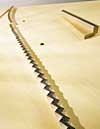
BLUEBOOK OF PIANOS
PIANO
CONSTRUCTION AND SCALE DESIGN

BRIDGES, PEDALS AND TRAP WORK
BRIDGES
The next step, and one of the most critical in the making of a fine piano, is the shaping of the treble and bass bridges. The bridges, of Northern hard maple, must be planed to exact thickness from end to end, so as to provide the proper down-bearing of the strings upon the bridges. It is this correct down-bearing which is so vital to the transfer of the string vibrations to the soundboard (resulting in pleasant piano tones).
Bridges should be glued to the sounding board with hot hide glue and further secured with wood screws from the back. Such screws should have maple buttons under their heads. The bridges must be accurately notched, at both top and bottom in the case of treble bridges, for each individual note. This provides for the "stopping" of the string at a precise point in much the same way as a violinist "stops" his strings be fingering. Bass bridges are planed on both edges for the same reason.
A time and money-saving way to do this important bridge notching is to notch the treble bridge on the top edge only. Half the work, half the cost and many piano buyers can't tell the difference unless they are able to distinguish subtle differences in piano tone.
PEDALS AND TRAP WORK
Most piano manufacturers offer three pedals. On most vertical pianos the pedal to the right is a full sustain pedal and by depressing it, the piano tone will linger on or sustain the note. The left pedal is known as the "Una Corda", which softens or limits the power of the tone by moving the action forward and limiting the distance the hammers travel. On a grand piano it shifts the action slightly, enabling the hammer to strike fewer strings.
A third pedal in the middle varies from brand to brand. It may serve to sustain the bass notes only, or it may act as another form of soft. In some cases, it drops a piece of felt to provide a muffler, or practice pedal.

On a grand, it becomes a true "Sustenuto", that is, allowing the pianist to sustain many notes as long as the pedal is held. A good way to tell about the quality of a piano is to hold a pedal in your hand and get a feel for it. Twist it and push it, then go to a more expensive piano and compare. You'll see the difference in quality. As a final point of clarification, many very fine pianos in the world only have two pedals, and for many years many American pianos including Steinway only used two pedals on many verticals. The center pedal on vertical pianos is an extra feature which can be a mute, a form of soft, or even a bass sustain. There is nothing wrong with having two pedals on a piano. For many years, that is all anyone had.
PIANO AGE | ARCHIVES | APPRAISALS | PIANO TYPES | BLUEBOOK VALUE | SELL A PIANO
Copyright © 2015 Bluebook of Pianos All Rights Reserved - Copyright laws exist to protect our intellectual property. They make it illegal to reproduce someone else's expression of ideas or information without permission. At one time, a work was only protected by copyright if it included a copyright trademark (the © symbol). According to laws established in 1989, however, works are now copyright protected with or without the inclusion of this symbol. Anyone who reproduces copyrighted material improperly can be prosecuted in a court of law. It does not matter if the form or content of the original has been altered -- as long as any material can be shown to be substantially similar to the original, it may be considered a violation of the Copyright Act.